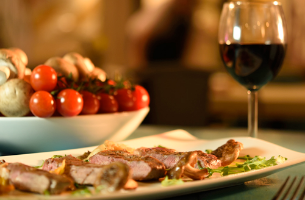
With shops, markets and delis crammed with exciting ingredients, there's never been a better time to get into food photography, whether you're shooting dishes or ingredients. Try these ideas for cooking up a storm with your camera.
With shops, markets and delis crammed with exciting ingredients, there’s never been a better time to get into food photography....

With shops, markets and delis crammed with exciting ingredients, there's never been a better time to get into food photography, whether you're shooting dishes or ingredients. Try these ideas for cooking up a storm with your camera.
Make sure your ingredients are in top condition, so avoid bruises or wrinkles on fruit, for example. Use plain crockery, cutlery and glassware, and make sure it's all sparkling. Food doesn't have to be arranged on a plate or in a dish, though – it could be on a board, slate or table top, or in a basket… think about what will best complement it and the overall feel you're aiming to create.
Spraying water onto fruit, raw veg and salads makes them look 'market fresh'. For best results with hot food, remove from the heat just before the cooking time is up, as it will continue to cook for a few minutes afterwards and could otherwise end up looking overdone in your images. If cooked dishes are starting to look a bit dried out, brushing them with oil helps. Try a variety of shots, some with the food untouched, and some with it 'enjoyed' – a biscuit broken in half, a loaf sliced, a few crumbs on the plate, a bite taken out.
To create a mouth-watering composition, you need to pay attention to composition and style. Wine glasses tend to look too tall in photos, so in professional shoots shorter glasses like sherry glasses are often used. Try shooting from different angles to get your food's 'best side'; you might need to rearrange it on the plate to get the best effect. Don't be too hung up about including cutlery in a 'meal' shot, as it can be distracting as well as cause unwanted reflections. In professional food photography, the current trend is to shoot from above for a very modern, graphic effect – a technique called flat lay.
If you want to capture steam rising from hot food, backlighting is essential and it also adds texture to prevent the image from looking flat. Avoid flash for that reason, too – instead use natural, diffused back-lighting or side-lighting from a window. You can soften shadows with a small reflector, if necessary; although shadows can be used to create a moodier effect.
Choose a small aperture (e.g. f/16) for deep depth of field, with everything pin-sharp front to back. Alternatively, use a wide aperture (e.g. f/2.8) – not only does it maximise natural light, it also creates a shallow depth of field which concentrates attention on the food and minimises distractions in front of and behind it. Using a wideangle or a macro lens will do this beautifully, but you can get a similar effect with a longer lens as long as you move back from your subject so you're beyond the lens's close-focus distance. If you want to focus on just one area of the food, go for the area of greatest contrast, as the eye tends to be drawn to that – otherwise you could end up with contrast and sharpness fighting each other for the viewer's attention.
• For food shots while you're eating out, it's always best to ask permission. If you get the go-ahead, keep it low-key so you don't disturb the other diners – shoot sitting down and avoid flash and tripods.
• Keep it simple – stick to available light, bump up the ISO if you have to, and don't cram too much onto the plate.
• With a COOLPIX, choose the food scene mode, which automatically enables the macro mode, cancels the auto flash and sets the AF area mode to manual. Alternatively, use the close-up mode.
You can now download a PDF version of this Hints & Tips article to read offline and print